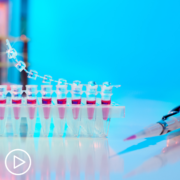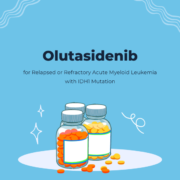Should AML Molecular Tests Be Repeated?
Should AML Molecular Tests Be Repeated? from Patient Empowerment Network on Vimeo.
Dr. Naval Daver, an AML specialist, reviews genetic testing, how the results affect AML treatment decisions, and when retesting may be appropriate for patients.
Dr. Naval Daver is an Associate Professor in the Department of Leukemia at The University of Texas MD Anderson Cancer Center. More about Dr. Daver here.
Related Resources:

|

|

|
Transcript:
Katherine:
What is genetic testing in AML?
Dr. Daver:
So, genetic testing in AML is basically what we call molecular profiling.
So, it’s looking at the presence of particular molecular mutations. For example, at MD Anderson, we do what we call 81 gene panel. So, this looks at 81 different genes for mutations in the bone marrow of newly diagnosed acute myeloid leukemia. Now, how did we come up with 81 genes? So, this was actually done by literature analysis and review of previously published preclinical and translational studies, and we basically selected all mutations that had been shown to occur in two percent or more of thousands of AML patients. And we found 81 such mutations. So, that any mutation that had a two percent or higher frequency in known published or public databases was included.
And that’s how we’re able to analyze for the mutation.
So, it’s still possible that there may be some very rare mutations that are present, and those may be important for research. But they don’t change our treatment decision today. And so that’s what we call genetic profiling. Some people call it molecular mutation analysis. Some people call it next-generation sequencing.
But basically, this is looking for mutations in particular genes that are known to occur in AML. Now of those 81 genes; and some people do a 100 gene panel, some do 50, so those are variables; but among those, there are four or five that are most important: the FLT3, as we discussed, where we can use FLT3 inhibitors; IDH1 and two, because we can use IDH1 and IDH2 inhibitors; TP53 is a very important mutation because it has very high risk and adverse prognosis.
And there are now new drugs coming that may be very effective in TP53. So, we are checking for that. Those drugs are in trials, but the trials are showing very promising data and could be a great option if a patient is known to have a TP53.
Those drugs are Magrolimab, CD47 antibody, and APR-246. So, these are the four most important therapeutic mutations.
There are also some mutations that have prognostic value even though we cannot target them. These include mutations like RUNX1, DNMP3A, ASXL1.
One does not need to know the list. But the point is that these mutations may help determine whether a patient falls into intermediate-risk group or high-risk group, which then impacts the decision as to whether we need a stem cell transplant or not. So, it really is important to get this molecular profiling. It’s actually available in the United States commercially. And any clinic or hospital is able to actually order it. And insurance will cover it in 100 percent of the cases.
Katherine:
When should patients be tested, and how is testing done?
Dr. Daver:
Yeah. So, the basic testing for any suspected new acute leukemia is to get a bone marrow biopsy. That has to be done. That should be done very quickly because all of the information that will be generated to make the treatment decision will come off the bone marrow biopsy.
Katherine:
What about retesting, Dr. Daver? Is that necessary?
Dr. Daver:
Yeah. So, retesting is necessary in – not for everything, I think.
But let’s say someone had treatment induction and relapsed a year later. So, we would definitely retest: 1) to confirm with the bone marrow’s relapsed AML, get the blast percentage because we need that before restarting treatment, so we know what was the starting point to know how the patients doing after treatment if he’s responding. 2) Molecular testing, for sure, should be repeated. We usually repeat the molecular testing such as FLT3, IDH1, IDH2, because there are drugs that can target these mutations in a relapse.
And more interestingly, we actually have published, and other groups have also published, that there are some patients who may not have those mutations at baseline but may actually acquire or have detectible mutations at relapse. So, if you don’t have FLT3 at baseline, your physician may assume that the FLT3 is not there, not do mutational testing. But in fact, that may not be true. So, it is important to retest about 15 percent, one five percent, in our publications can acquire a detectible FLT3. Which is critical because this could then change your treatment.
IDH1 and two are rarely lost or acquired, but we have seen a few five percent or so cases of that. So, it’s still better to check for that. And then TP53 we check for because now we have these new research clinical trials, phase one, two, that are showing some very encouraging activity in TP53. So, these are probably the main things to retest for.
There’s also some new clinical data emerging with a new drug called menin inhibitor that targets a particular chromosome abnormality, MLL rearrangement.
This is again in a phase one setting, so the data may not be widely disseminated. But we’re seeing some very encouraging activity with menin inhibitors.
And so, we are 100 percent checking for the MLL rearrangement chromosome, which can be done on FISH, or routine chromosome.
And if that is there then trying to get on one of the menin inhibitor trials, they’re opening about 25, 30 centers with different menin inhibitors, would be a very, very good option because we think these will be the next molecular or chromosome-targeted breakthrough in AML.










